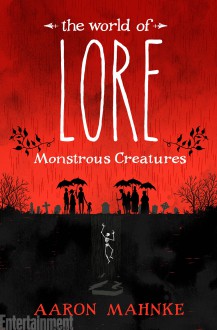
Only as I'm reviewing these books do I realize just how many 'scary' books I read at the end of last year (and how many more I've just now added to my TRL). That's how you know that I'm a 'whatever I feel like reading' reader/'I'm interested in this topic for the next 3 books and then I'm going to wildly change interests' reader. [A/N: I couldn't remember the term 'mood reader' to save my life when I was originally drafting this post. I chose to leave that crazy line in there because it cracks me up.] All of this is to set up today's book which is The World of Lore: Monstrous Creatures by Aaron Mahnke. I saw an ad for this in a subway station and it wasn't the title that caught my eye but the author. I had been an avid listener of his podcast (named Lore unsurprisingly) last year and then as is my way (especially with podcasts) I had totally forgotten about it. Once I started reading the book I realized that it was essentially composed of transcripts from his podcast episodes. (Guess it's a good thing I didn't listen to all of them.) The book is broken down into categories about different creatures from folklore. Two examples: vampires and zombies. Vampires could have been created because of a disease whereby people were pale, sensitive to sunlight, and craved blood. (And then there was Vlad the Impaler who is perhaps the most well-known nightwalker. (Quick note: Nightwalker is not a cool name for a vampire like I had originally thought but I'm gonna just pretend that it is cause it's better than repeating the word vampire ad nauseum.)) Zombies were most likely inspired by victims of tuberculosis (the living dead) and the large numbers of people who were pronounced dead then subsequently rose from their graves. (This is a real thing and will perhaps explain why more people choose cremation these days.) Mahnke also discusses the history of hauntings and the popularity of the spirtualist movement among many other topics of the supernatural. He has a way of simultaneously debunking these theories while giving the impression that we should still remain open-minded. It's an interesting read especially if you haven't really delved too deep into this subject area and you want to get the rundown. 8/10
Monstrous Creatures is the first in a planned trilogy and I think there's also a tv show in the works. I guess I'm not the only one interested in the supernatural. ;-)
What's Up Next: Soonish by Kelly Weinersmith
What I'm Currently Reading: Gorillas in the Mist by Dian Fossey

 Log in with Facebook
Log in with Facebook 











